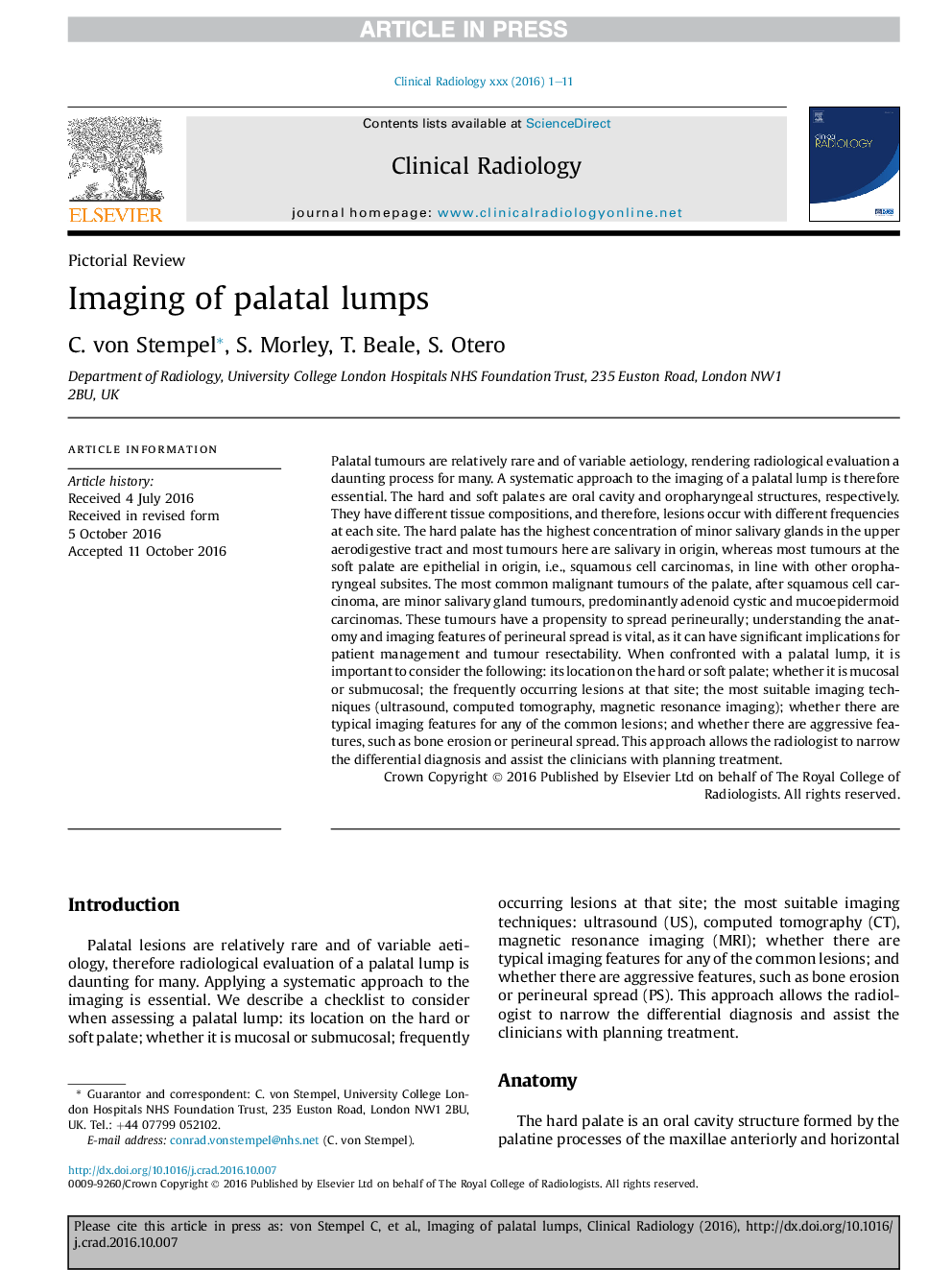| کد مقاله | کد نشریه | سال انتشار | مقاله انگلیسی | نسخه تمام متن |
|---|---|---|---|---|
| 5700629 | 1410575 | 2017 | 11 صفحه PDF | دانلود رایگان |
عنوان انگلیسی مقاله ISI
Imaging of palatal lumps
ترجمه فارسی عنوان
تصویر برداری از توده های پالاتال
دانلود مقاله + سفارش ترجمه
دانلود مقاله ISI انگلیسی
رایگان برای ایرانیان
ترجمه چکیده
تومورهای پالادی نسبتا نادر هستند و از علل متغیر هستند، که ارزیابی رادیولوژیکی یک روند دلهره آور برای بسیاری است. بنابراین رویکرد سیستماتیک به تصویربرداری یک توده پالاتال، ضروری است. کوفته های سخت و نرم حفره دهان و ساختار رحمی را تشکیل می دهند. آنها دارای ترکیبات بافت متفاوت هستند و بنابراین ضایعات با فرکانس های مختلف در هر محل رخ می دهد. کمپوت سخت بالاترین غلظت غدد بزاقی بزرگی را در دستگاه آئروادژستیک بالایی دارد و بیشتر تومورها در اینجا منشا بزاق هستند، در حالیکه اکثر تومورهای قارچ نرم در اصل منشأ اپیتلیال هستند، به عنوان مثال، کارسینوم سلول سنگفرشی، به صورت مشابه با سایر زیرمیزی های رحمی. شایعترین تومور بدخیم شکم پس از کارسینوم سلول سنگفرشی، تومورهای غدد بزاقی بزاق، عمدتا آدنوئید کیستیک و موکوپیدرموئید کارسینوم هستند. این تومورها تمایل دارند که به طور طبیعی گسترش پیدا کنند؛ درک ویژگی های آناتومی و تصویربرداری از گسترش پریمرال حیاتی است، زیرا می تواند پیامدهای قابل توجهی برای مدیریت بیمار و ریزش موی تومور داشته باشد. هنگامی که با یک توده پاتال مواجه می شوید، مهم است که موارد زیر را در نظر داشته باشید: محل آن بر روی سادگی سخت یا نرم؛ آیا آن مخاطی یا زیر حفره است؟ ضایعات غالبا رخ داده در آن سایت؛ بهترین تکنیک های تصویربرداری (اولتراسوند، توموگرافی کامپیوتری، تصویربرداری رزونانس مغناطیسی)؛ آیا ویژگی های تصویربرداری معمول برای هر یک از ضایعات رایج وجود دارد؟ و اینکه آیا ویژگی های تهاجمی مانند فرسایش استخوانی یا گسترش پرانرژی وجود دارد. این روش به متخصص رادیولوژیست اجازه می دهد تا تشخیص افتراقی را محدود کند و درمانگران را با برنامه ریزی درمان کند.
موضوعات مرتبط
علوم پزشکی و سلامت
پزشکی و دندانپزشکی
تومور شناسی
چکیده انگلیسی
Palatal tumours are relatively rare and of variable aetiology, rendering radiological evaluation a daunting process for many. A systematic approach to the imaging of a palatal lump is therefore essential. The hard and soft palates are oral cavity and oropharyngeal structures, respectively. They have different tissue compositions, and therefore, lesions occur with different frequencies at each site. The hard palate has the highest concentration of minor salivary glands in the upper aerodigestive tract and most tumours here are salivary in origin, whereas most tumours at the soft palate are epithelial in origin, i.e., squamous cell carcinomas, in line with other oropharyngeal subsites. The most common malignant tumours of the palate, after squamous cell carcinoma, are minor salivary gland tumours, predominantly adenoid cystic and mucoepidermoid carcinomas. These tumours have a propensity to spread perineurally; understanding the anatomy and imaging features of perineural spread is vital, as it can have significant implications for patient management and tumour resectability. When confronted with a palatal lump, it is important to consider the following: its location on the hard or soft palate; whether it is mucosal or submucosal; the frequently occurring lesions at that site; the most suitable imaging techniques (ultrasound, computed tomography, magnetic resonance imaging); whether there are typical imaging features for any of the common lesions; and whether there are aggressive features, such as bone erosion or perineural spread. This approach allows the radiologist to narrow the differential diagnosis and assist the clinicians with planning treatment.
ناشر
Database: Elsevier - ScienceDirect (ساینس دایرکت)
Journal: Clinical Radiology - Volume 72, Issue 2, February 2017, Pages 97-107
Journal: Clinical Radiology - Volume 72, Issue 2, February 2017, Pages 97-107
نویسندگان
C. von Stempel, S. Morley, T. Beale, S. Otero,
